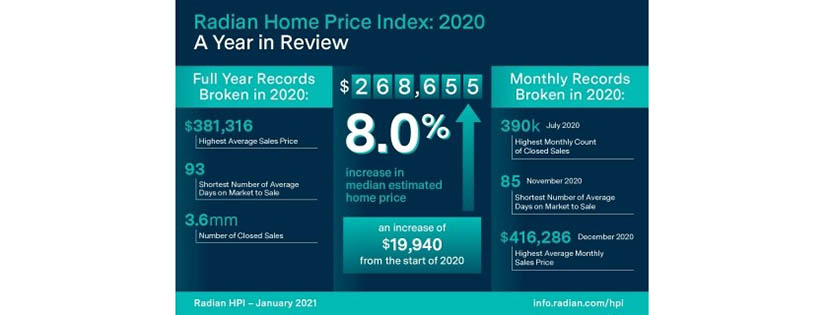
Radian: 2020 U.S. Home Prices ‘Bright Spot in a Dark Year’

Radian, Philadelphia, said performance of the U.S. residential real estate markets, and in particular home price appreciation, marks a bright spot in 2020.
The company’s monthly Home Price Index data released by subsidiary Red Bell Real Estate LLC said home prices nationally rose from the end of November to the end of December at an annualized rate of 8.5 percent. For the full year, the Radian HPI rose 8.0 percent year-over-year (December 2019 to December 2020).
Steve Gaenzler, Radian Senior Vice President of Data and Analytics, said the year was a tale of two halves: for the first six months of the year, home prices nationally appreciated at an annualized rate of just 6.5 percent. However, the last two quarters recorded an annualized increase of 9.3 percent. For the calendar year, national real estate records were broken in several important statistical categories:
• Highest Average Sales Price $381,316
• Shortest Days on Market to Sale 93
• Number of Closed Sales 3.6 million
• Average Active Monthly Listings 1.2 million
“In the end, there was nothing typical about 2020,” Gaenzler said. “As the country shut down in March, no one predicted what would happen over the remainder of the year. Despite a global pandemic, social unrest at levels not seen in generations, and a divisive political environment, the U.S. housing market thrived. In many ways, this was a Black Swan outcome, albeit a positive one.”
Gaenzler noted the confluence of fiscal policy, monetary policy, the administration and private sector innovation such as remote valuations, digital closings and many other product innovations, “paved the way to not just stabilize housing, but to create an environment for strong growth.”
Radian reported the national median estimated price for single-family and condominium homes rose to $268,655, a more than $19,940 increase in the calendar year. Across the U.S., home prices nationally rose 9.4 percent in the final quarter, the strongest quarter of the year, and a strong increase over the first, second and third quarter appreciation rates of 6.3, 6.6 and 8.9 percent respectively.
“The imbalances between housing supply and demand continued to provide solid support for home prices throughout the year,” Radian said “On the demand side, December 2020 recorded the highest level of monthly home sale transactions as compared to any previous December and was the second strongest month of any fourth quarter. Strong demand for limited supply continues to keep the average number of days that a property for sale is listed before going under contract in December at the shortest levels in over a decade, and near the record low for days on the market.”
Five of six regions had stronger home price appreciation in 2020 than in 2019. The Mid-Atlantic region, which includes New York, Philadelphia and the Washington-Baltimore region (all areas severely impacted by COVID-19 and associated economic pains), was the only region to record lower annual appreciation. However, at +6.5 percent, the region still did quite well. The strongest performing region of 2019, the Midwest, held on to the title through 2020. Notably, the West and Northeast, two of the weakest performing regions of 2019, were the second and third best in 2020. Other than the MidAtlantic, regional performance was similar with all regions ending the year with appreciation rates between 7.5 and 9.1 percent.
Similar to the national level, states broke records in nearly all transactional categories:
• Highest Number of Closed Sales 37 states
• Highest Average Sales Price 47 states
• Highest Average Listing Price 46 states
• Shortest Days on Market to Sale 31 states
All 50 states recorded positive home price appreciation in 2020. Forty-four states recorded faster appreciation in 2020 compared to 2019. In 2020, in the 10 most populous states, all captured home price growth faster in 2020 than 2019 and the average increase was above the national average.
Across the 20-largest metro areas of the U.S, the second half of the year dramatically outperformed the first half. Five metro areas, Chicago, Boston, Philadelphia, Miami and Riverside, Calif., recorded price appreciation rates in the second half of the year at more than double that of the first half. For the year, all but one metro (Baltimore) logged higher 2020 appreciation rates than 2019. The average median estimated home price of homes in the 20-largest metros is higher by more than $24,450 over the past 12 months.
